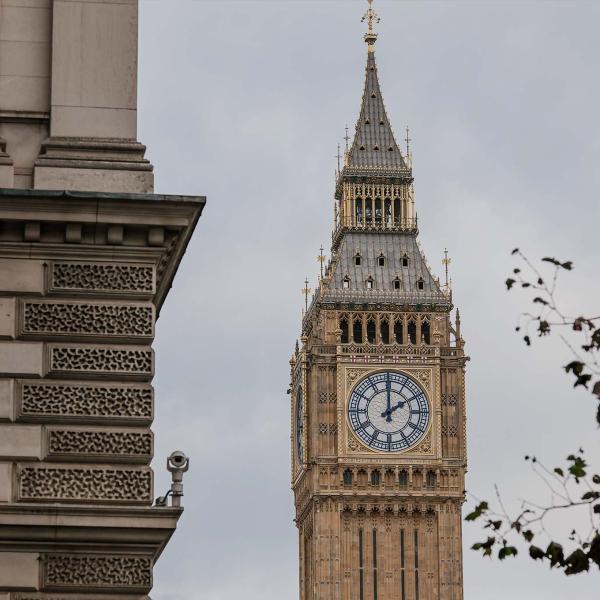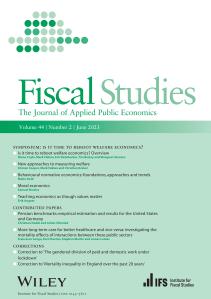In yesterday’s English Provisional Local Government Finance Settlement, the government announced councils will be able to set a ‘Social Care Precept’ of 3% a year over the next two years, rather than the 2% a year previously planned, to raise additional funds for adult social care. Coming on top of the 2% increase in bills councils are allowed to levy to generate funding for other services (such as libraries, children’s services and refuse collection), if these new powers were used in full, Band D council tax could increase by an average of £67 (£27 in real-terms) in April 2017 and £136 (£56 in real terms) by April 2018.
However, the flip side is that if councils make full use of the 3% precept in each of the next two years, they will not be able to use the precept in April 2019: a cap of 6% in total over the next three years applies. In other words, council tax increases can be brought forward to raise money in the short term, but this will do nothing to plug the longer-term funding issues adult social services (and councils more generally) face. Furthermore, the new ‘Adult Social Care Grant’ also announced yesterday is only available in 2017–18, and is largely a relabeling of money councils were going to receive anyway.
We calculate that yesterday’s announcements could increase the amount available to spend on adult social care by a maximum by £700 million over the next two years relative to previous plans. But they provide no boost to spending beyond that.
Adult social care spending and the social care precept
In the last financial year, 2015–16, councils’ net expenditure on adult social services was £14.6 billion, a little over one third of their overall spending on services (excluding education). Measured on a consistent basis, this has fallen in real terms by almost 20% since 2009–10 despite a growing elderly population.
In the 2015 Spending Review, the Chancellor announced two policies to provide additional funding for this area:
- The ‘Social Care Precept’ allowing councils with social care responsibilities to increase council tax by an extra 2% a year (on top of the usual 2% limit) if that funding were allocated to adult social services. This raised around £380 million in 2016–17, which would have risen to £1.7 billion per year in real-terms by 2019–20, if used in full (See row 1, Table 1).
- The ‘Improved Better Care Fund’ was additional grant funding, amounting to £100 million a year in 2017–18 and £1.4 billion a year in real-terms by 2019–20 (see row 2, Table 1). This funding was to be allocated to councils in such a way as to offset differences in their ability to raise their own revenues for social services via council tax.
Taken together, these plans meant £3.1 billion of ‘extra’ funding ring-fenced for social care by 2019–20. If this money were added to existing budgets, real-terms spending on adult social care would have grown 1.3% in real terms this year and 14.7% in real terms by 2019–20.
Table 1. Potential additional resources for adult social services, £ millions (2016–17 prices)
Policy measure | 2016–17 | 2017–18 | 2018–19 | 2019–20 |
Original plans |
|
|
|
|
(1) Social Care Precept | 382 | 793 | 1,221 | 1,668 |
(2) Improved Better Care Fund | 0 | 104 | 796 | 1,421 |
(3) Total ((1) plus (2)) | 382 | 897 | 2,017 | 3,089 |
|
|
|
|
|
New plans |
|
|
|
|
(4) Social Care Precept | 382 | 999 | 1646 | 1,662 |
(5) Improved Better Care Fund | 0 | 104 | 796 | 1,421 |
(6) Other extra grant funding | 0 | 75 | 0 | 0 |
(7) Total ((4) plus (5) plus (6)) | 382 | 1,178 | 2442 | 3,083 |
|
|
|
|
|
Total extra funding under new plans ((7) minus (3)) | 0 | 281 | 425 | -6 |
Note: Figures for 2016–17 reflect revenue forecasts based on actual usage of Social Care Precept in that year, as reported in https://www.gov.uk/government/statistics/council-tax-levels-set-by-local-authorities-in-england-2016-to-2017. Figures for later years assume full use of Social Care precept by relevant authorities (on top of 2% increases in council tax rates each year for general purposes). The ‘Other extra grant funding’ refers to the net effect of the shift of funding from the New Homes Bonus to the Adult Social Care grant for councils with social care responsibilities. It reflects a net shift of £75 million from District Councils to councils with responsibility for social care.
Councils’ budgets for this year show them planning to spend £14.4 billion on adult social services – actually less than the £14.6 billion spent last year, despite the £380 million forecast to be raised from the ring-fenced ‘Social Care Precept’. This has happened because councils’ overall budgets fell between the two years and the way the ring-fence works is that councils simply have to confirm that they are using the precept and Better Care Fund to spend more than they otherwise would have on such services. Thus a fall in spending is perfectly consistent with satisfying the ring fence if councils state that they have cut spending by less than they otherwise would have done.
Looking ahead, the Government yesterday announced that in April 2017 and April 2018, councils will be able to set the precept at 3% rather than 2% as previously planned. If used in full, this would raise a little over £200 million more than previous plans next year, and £425 million more in 2018–19.
The government also announced a new £240 million Adult Social Care Grant for 2017–18. This comes from reductions to the generosity of the New Homes Bonus, paid to councils based on the number of new homes that are built in their areas. Thus, councils with social care responsibilities see a net increase in their grant funding of only £75 million in real-terms (paid for by a net cut to grants to District Councils, who will also see smaller New Homes Bonus payments, and are not responsible for social care provision). Added to the revenue from the higher ‘Social Care Precept’, the new plans therefore provide an additional £280 million in ring-fenced funding next year on top of the extra already in the pipeline. This is not an insignificant sum, but is small relative to the scale of the estimated funding gap in the social care sector – see for example this joint paper by the Nuffield Trust, Health Foundation and Kings Fund which estimated a funding ‘gap’ of £1.9 billion in 2017–18, for instance).
Importantly the amount spent on social care may well not go up in line with the ring-fenced grants: councils could still cut spending provided that they state that they have used this money to cut by less than they otherwise would.
Councils’ overall spending power, including the ring-fenced funds for social care funding, is set to fall 2.6% next year. If social care spending fell in line with this overall cut, that would mean a cut of around £375 million in real-terms. If, on the other hand, the ring-fenced funds are used in full to boost spending on social services, spending would rise by around £425 million (3%) in real-terms compared to this year. But to balance their budgets councils would need to make cuts of around £1.5 billion (5.3%) to other service areas.
Looking further ahead, if councils make full use of the 3% precepts in 2017–18 and 2018–19, they will not be able to levy an additional precept in 2019–20 (the usual 2% limit on council tax would apply). In other words, the main impact of yesterday’s announcements was to bring forward funding increases for adult social care. How the government plans to address longer-term spending pressures arising from an ageing population, increases in labour costs as a result of the National Living Wage, and the costs of a more generous social care regime planned for 2020 and beyond, remains unclear.
Impact across councils
Because of differences in council tax revenues and social care needs around the country, the relative amount councils can raise from the ‘Social Care Precept’ varies substantially between councils: areas with high valued homes and low needs can raise relatively more. The ‘Better Care Fund’ is being allocated to compensate for these differences, so that by 2019–20, the overall additional funding available is much more equally distributed around the country.
However, the backloading of the Better Care Fund (it is set to be just £100 million next year), and the front-loading of the increases in council tax via the ‘Social Care Precepts’ mean that in 2017–18 and 2018–19, areas with lots of high valued properties and/or low needs will see a relatively bigger increase in the resources available for social care. Overall, yesterday’s announcements brought forward into the next two years relatively more funding in areas with higher valued properties and/or lower needs.
Areas with lots of low valued properties and/or higher needs will then see a bigger boost than more affluent areas in 2019–20 as the ability to levy additional Social Care Precepts is exhausted and the Better Care Fund – targeted at those low valued / high needs areas – continues to increase.
Households’ council tax bills
We now turn to what yesterday’s announcements mean for households’ council tax bills.
In 2015–16, the average Band D council tax bill in England was £1,484. Adjusting for consumer price inflation, this was 7% lower than in 2010–11, reflecting a widespread council tax freeze. The ending of the council tax freeze and the introduction of the ‘Social Care Precept’ led to a 3.1% cash-terms (2.1% real-terms) increase in council tax in 2016–17, taking the average Band D rate to £1,530.
All councils outside London able to use the precept report using the full 2% allowed in 2016–17. However, at the same time, a substantial minority of councils decided not to make use of the full 2% increase to council tax for general purposes. This, of course, kept households’ bills down, but means that these councils did not raise as much as they could via council tax to support local services (including adult social services).
Looking to the future, the amount of council tax households in England will pay will depend on the extent to which councils make use of the new higher 3% social care levy over the next two years, and the increases in their ‘general’ council tax rates. If all councils make full use of the precept, and of the 2% increases to standard bills that are allowed, average Band D council tax would increase £67 next April (£27 in real terms), and would be £136 higher by April 2018 (£56 in real terms). Increases in different parts of the country will vary with the biggest increases allowed in those areas where council tax rates are already highest (because the standard 2% increases and 3% precepts are bigger when initial council tax rates are higher).
However, council tax bills would still be lower in real-terms in 2018–19 and 2019–20 than they were in 2010–11: the increases in bills this year and over the next few years will not fully undo the coalition government’s council tax freeze.
Summary
Yesterday’s announcements therefore represent a modest increase in funding for social care in the short-term, largely paid for by above-inflation increases in council tax, and a small reduction in grants to District Councils next year.










